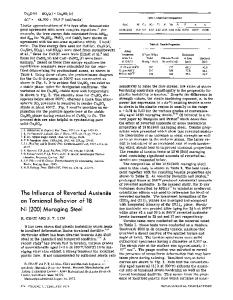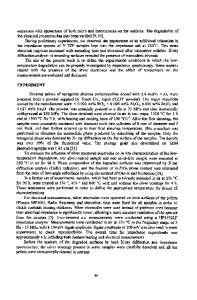Thermodynamic stability of tetragonal zirconia nanocrystallites
- PDF / 149,556 Bytes
- 4 Pages / 612 x 792 pts (letter) Page_size
- 79 Downloads / 314 Views
Irene A. Rusakova Texas Center for Superconductivity at University of Houston, Houston, Texas 77204-5932 (Received 21 August 2000; accepted 6 December 2000)
The thermodynamic stability of tetragonal (t-) ZrO2 nanocrystallites below the bulk stability temperature 1200 °C was studied through specially synthesized crystallites that exhibited an extremely slow coarsening rate. The nanocrystallites were mechanically transformed to the monoclinic (m-) structure, and, because the crystallite size was kept below approximately 20 nm, the t-structure was completely recovered solely by thermal treatments between 900 and 1100 °C. These results gave strong evidence to the notion that, for sufficiently small crystallite size, nanocrystalline t-ZrO2 is not just kinetically metastable but can be truly thermodynamically more stable than the mpolymorph in air below 1200 °C.
I. INTRODUCTION
Tetragonal (t-) zirconia (ZrO2) has been applied as “superacid” catalysts for hydrogenation and isomerization reactions,1,2 an oxygen sensor,3,4 and “superplastic” structural ceramics that possess an excellent strength and fracture toughness.5–8 These unique mechanical and catalytic properties are manifest only for t-ZrO2 but not for the monoclinic (m-) polymorph. Although m-ZrO2 is thermodynamically the most stable polymorph below approximately 1200 °C in bulk form,9 t-ZrO2 has often been synthesized from amorphous ZrO2 well below this temperature in large quantities in the form of nanometric crystallites.10–14 Whether or not these nanocrystallites are truly thermodynamically stable has been a subject of serious debate for decades. Those models that consider t-ZrO2 nanocrystallites to be thermodynamically more stable than the m-ones attribute the enhanced stability to different energy contributions other than the bulk free energy.15–20 One notable example of the “thermodynamic” group is due to Garvie,15,16 who assumed that t-ZrO2 has a lower surface free energy than m-ZrO2 under certain environments and that t-ZrO2 nanocrystallites occur spontaneously so long as they are small enough to give a large enough surface to counteract the difference in bulk energy; i.e., (Gt − Gm) + (St␥t − Sm␥m) < 0, where G is bulk free energy, S the surface area, and ␥ the specific
a)
Address all correspondence to this author.
666
http://journals.cambridge.org
J. Mater. Res., Vol. 16, No. 3, Mar 2001 Downloaded: 07 Apr 2015
surface energy. Collins and Bowman20 and Srinivasan et al.,21 on the other hand, considered the contribution of surface defects. Those considering the nanocrystallites to be only kinetically “metastable” attribute their “temporary” existence to the assumption that formation of t-crystallite is kinetically preferable to m-crystallite from amorphous ZrO2. For instance, Tani et al.,22 proposed a model of topotactic crystallization of t-ZrO2 on nuclei in amorphous ZrO2. Their argument was primarily based on Livage et al.’s finding that the interatomic Zr–Zr and Zr–O distances in amorphous (hydrous) ZrO2 were similar to those in the t-structur
Data Loading...











